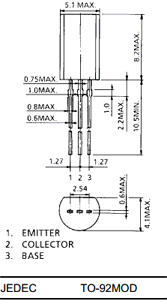

Let see how to find an operating point with an example or problem. Hope you know well about operating point. So when we draw this load line, a point at which load line intersecting with Ib is called the operating point or q-point. So now we already find two points( A and B) of this load line. We provide biasing to the transistor to ensure that it operates in the active region. Consequently, the transistor will function normally in this region. In the active region, collector-base junction remains reverse biased while base-emitter junction remains forward biased. For finding intersecting points of load line with X-axis and Y-axis we take one by one Ic=0 and then Vce=0. The region between cut off and saturation is known as active region. The output characteristics of this transistor show graph between Ic and Vce. For general transistor biasing circuit, output circuit equation is How to find an operating point?įor finding operating point first we have to find load line points( A and B ) on Ic and Vce. For operating point, we have to find load line. This point is also called as Q point or quiescent (Silent) point because it is a point of output characteristics when a transistor is silent i.e. It is called the operating point because the variations of Ic and Vce take place at this point when an input signal is applied. “ The zero signal values of collector current (Ic) and collector-base voltage (Vcb) are known as operating point for that transistor”. So if we want to call what is an operating point? in one line so we can say that, The operating point is a point which we can obtain from the value of collector current Ic and collector base voltage Vcb at no input signal is applied to the transistor.

The operating point is a specific point on transistor output characteristics at which we get good biasing for that transistor. Here we also know how we can find Q point of BJT transistor. In fact, small signal amplifiers are the most common linear devices.Here we discuss what is the operating point of transistor? or Q point of a transistor?. Amplification means linear amplification. Therefore, a transistor acts as an amplifier when operating in the active state. When the transistor is in the active state, I C = I B. That is the transistor behaves as though a switch has been closed between the collector and emitter. In saturation, the collector and emitter are, in effect, shorted together. That is collector emitter pathway is open If the transistor is cut-off, there is no base current, so there is no collector or emitter current. In the active state, collector current is β times the base current ( i.e. SATURATED : Emitter diode and collector diode are ON. The relations between the diode states and the transistor states are :ĬUT-OFF : Emitter diode and collector diode are OFF.ĪCTIVE : Emitter diode is ON and collector diode is OFF. The state of a transistor is entirely determined by the states of the emitter diode and collector diode. hspice.book : hspice.ch14 1 Thu Jul 23 19:10:43 1998 Star-Hspice Manual, Release 1998. We have seen above that transistor can act in one of the three states : cut-off, saturated and active.

The junction between base and collector may be called collector diode. The junction between base and emitter may be called emitter diode. A transistor has two pn junctions i.e., it is like two diodes. The reader may find the detailed discussion on transistor biasing in the next chapter. The region between cut off and saturation is known as active r egion. If base current is greater than I B( sat), then collector current cannot increase because collector-base junction is no longer reverse-biased. At saturation, collector-base junction no longer remains reverse biased and normal transistor action is lost. At this point, the base current is maximum and so is the collector current. The point where the load line intersects the I B = I B( sat) curve is called sa turation. The collector-emitter voltage is nearly equal to V C C i.e. At cut off, the base-emitter junction no longer remains forward biased and normal transistor action is lost. At this point, I B = 0 and only small collector current ( i.e. The point where the load line intersects the I B = 0 curve is known as cut off. ( i) shows CE transistor circuit while Fig.( ii) shows the output characteristcs along with the d.c.


 0 kommentar(er)
0 kommentar(er)
